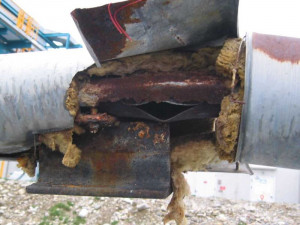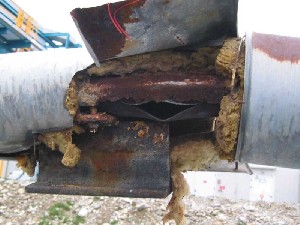During efforts since the previous day to locate the source of a pressure drop on the cyclohexane supply line of an olone production facility, a leak of this substance was discovered at a chemical site. The substance, used in large quantities, is of relatively low toxicity, although it a pollutant and flammable.
Stored in a 10,000 m³ reservoir, the cyclohexane is supplied to the olone and adipontrile (ADN) facilities by a partly common pipeline. Maintained at the proper temperature by a steam system, the cyclohexane is transferred at 20°C and at 2 to 3 bar through lagged overhead or underground piping. With an output ratio of 266:1, 2 pipes, 100 and 40 mm, provide a continuous supply to the olone shop and a discontinuous supply to the ADN shop.
According to the operator, the leak occurred from the rupture of the ADN shop’s 40 mm pipe due to the dilation of liquid cyclohexane in the overhead part of the pipe between two blockages of crystallized cyclohexane. A malfunction of the pipe heating device (T < 6.5°C) led to the formation of blockages, with the cyclohexane then reliquifying primarily in the section the most exposed to the outside heating. As the piping was not yet equipped with a device for rapid leak detection, it took 30 hours to determine the cause of the pressure anomaly. The operator initially estimated the leak at just a few m³ of cyclohexane, then between 850 and 1,200 t in the following weeks, the vast majority had migrated into the ground. A few days later, core samples taken at a depth of 13 m (the depth of the water table) showed the presence of a layer of cyclohexane localized near the site of the leak; lowering of the water table by one of the wells of the site's hydraulic security barrier would have limited the spread of the pollution. Analyses of the water table off site showed no trace of cyclohexane above the drinkability threshold.
On July 2, 2003, 420 t of cyclohexane were pumped from the water table and 16 t extracted from the ground through venting techniques… In July 2004, 590 t of cyclohexane had been recovered, although cleanup operations had slowed considerably since the first of the year, with the quantities of cyclohexane recovered stabilising around ten tonnes per month. Consequently, a Prefectural order was issued July 28, 2004 to request that risk analysis be conducted within the scope of a remedial plan.
Download the detailed report in .pdf format (135 Kb)





